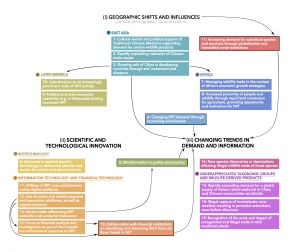Proactive engagement with wildlife trade issues in an unsettled world
In the belief that we need to move beyond crisis management and towards proactive measures and solutions, we conducted a horizon scan of significant, emerging issues in the global illegal wildlife trade (IWT). The resulting paper, identifying potential future risks and opportunities, and offering insights on how to respond to them, has recently been published in Conservation Letters.
Horizon scanning was initially developed to better understand future political movements and capitalise on budding business opportunities. It has been used in multiple fields, including emerging health technologies and infectious diseases, aging populations, and for other conservation-related topics, such as Myanmar forest conservation. The end goal of horizon scanning is to prevent limited resources from being misdirected, and to highlight both the costs of ignoring emerging threats and the need to implement decisions and policies to mitigate such threats before they potentially reach crisis levels.
There are many historic instances (including the current pandemic) that illuminate how ill-prepared we have been for such crises. Looking back at examples, it seems plausible that more of us could have foreseen a problem emerging if only we had been actively considering it, thereby prompting us to act to reduce future impact, ahead of time.
Can this crisis help reframe our thinking and provide a wake-up call both for the health of our global population and our planet to act more preemptively?
Top issues on the IWT horizon

Issue number 11: Increasing demand for substitute species and products through globalisation and intensified trade restrictions.
We use the term ‘issues’ to refer to challenges/risks/threats that may exacerbate IWT or opportunities/advancements that may help us to tackle IWT. To come up with the list of top issues, we adapted existing horizon scanning methods, systematically examining future possibilities in an open, inclusive, and global participatory way. We used a democratic and transparent iterative process to identify and prioritise ideas from various sources, involving 150+ people across diverse backgrounds and geographies (including 38 nationalities) with a core working group of 25 individuals.
The top 3 ranked issues identified in our scan highlight China’s role as a critical player in the global IWT, a perception that has been reinforced with it being the apparent source of the coronavirus responsible for the COVID-19 pandemic. Although the exact mechanism of the original virus transmission to humans remains unclear, an early link to the Wuhan wet market (which sold a range of animal products, including wildlife) has raised the profile of the IWT activity and unsanitary conditions often associated with such markets.
While global IWT policy making involves a range of decision-makers and stakeholders, efforts have often focused on enforcement, technical assistance, and capacity building. However, effective measures to counter IWT ultimately hinge on the political will of nation states; wildlife trade policy discussions need to incorporate a deeper understanding of complex market and trade dynamics (including consumer demand), as well past and future trends to be effective.
The top 20 horizon scan issues related to three different, but interconnected themes: developments in biological, information and financial technologies; changing trends in demand and information; and socio-economic and geopolitical shifts and influences (Figure 1: To find more about each specific issue, see our paper (particularly the supplementary material for their descriptions and policy relevance)).
These issues illustrate that we live in a networked, but dynamic and rapidly changing world. Understanding the associated complexities can guide us toward actions and processes that effectively address IWT. Our analysis suggests that these should be locally led, but encompass broader geopolitical and socio-economic considerations, with a focus on critical regional trade centres.

The top 20 issues with linkages drawn between them. Numbering represents the rank order of the issues. Those outlined in black are cross-thematic issues
The publication of this paper comes 2 years after the project started (early 2018) and we have since seen increasing awareness of many of the top issues, previously relatively unknown, or merely not at the forefront of IWT discourses. Examples of how issues have continued to emerge are numerous – here is one:
Africa and East Asia have long been the focus of IWT priorities, but over the last few years Latin America has emerged as an underrepresented node of high IWT activity, though our understanding of the mechanisms behind increased poaching and trafficking still lag (Issue 20). The frontier of IWT in Latin America has since increased, with more attention brought forth by both the conservation community (October 2018) and global political leaders. Peru hosted the First Americas Regional Conference on the Illegal Trade in Wildlife in Lima (October 2019), during which the Lima Declaration was enacted alongside commitments and statements made to curb future regional IWT activity.
Thinking ahead
One key achievement of this project was its success in bringing together researchers and practitioners from different sectors and disciplines to amplify a topical global conversation. The ability to remotely engage dispersed groups across the world has already become more important, as we continue to adopt new ways of connecting virtually.
Crises like COVID-19 or the 2008 global financial crash have forced our society and markets to adapt and innovate. Businesses and individuals have found interesting ways to reinvent themselves, often bouncing back stronger. However, adaption and innovation are not just reserved for goods and services; they can be used to reshape our thinking as conservationists too.
This analysis can support national governments, international bodies, researchers and non-governmental organisations as they develop future strategies for IWT. It can guide greater coordination of preemptive interventions, integrated across sectors and policy arenas. We are optimistic that such future-orientated exercises will influence conservationists to actively shift their focus from responding to crises to preparing for what lies on the horizon.
Interested to know more?
Contact the authour, Nafeesa Esmail, here.
Access the full paper here.
Over the next few weeks, a series of posts on top emerging issues within the illegal wildlife trade will be shared through our ‘on the IWT horizon’ commentary series. Watch this space for:
- Rapidly expanding demand for a global supply of Haiwei (dried seafood) to China and Chinese communities worldwide by Jack Lam
- Social media influencing IWT networks and consumer behaviour by Zara Bending
- New species discoveries or descriptions affecting illegal wildlife trade of those species by Catherine Workman
- Managing wildlife trade in the context of Africa’s economic growth policies by Andrea Athanas
You can also read the CITES CoP18 policy briefing document for strategic IWT decision-making based on this IWT horizon scan.




 OMP-WT
OMP-WT J. Lam
J. Lam